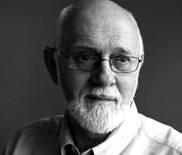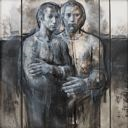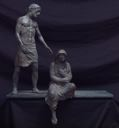Trevor Jack Thomas Southey
(Rhodesia, Africa (now Zimbabwe), 1940 - 2015, Salt Lake City, Utah)
Trevor Southey is a native of Rhodesia (Zimbabwe), Africa, born in 1940 of immigrant European ancestry. His interest in art developed at an early age when rheumatic fever confined him to bed for months at a time, and often, his only companions were a pen, pencil, and paper. Southey attended art schools in England and South Africa before coming to the United States in 1965 to attend Brigham Young University (BYU). After receiving his degrees, he joined the BYU art faculty. While teaching there, he became a founding member of the highly significant Mormon Art and Belief Movement (1966-1976). Southey personally worked to establish a "Mormon Art" form through his use of Latter-day Saint theology. In 1977, he decided to dedicate his full energies to an art career, resigned from the faculty at BYU and, in 1982, established a studio in Salt Lake City. As a Figurative-Realist, Southey, like the Renaissance painters, uses the physical body to portray the soul. Rather than merely depicting the figure, he unconsciously evokes the spirituality of the human form through his use of other-worldly, everyman figures, combining realism with personal allegorical content. Talking about his art and his life, Southey says, There is a strange element of surprise in suddenly finding oneself middle-aged, and internalizing the fact that one is perceived as an artist. There was not really any other natural thing for me to do with my life. . . . Certainly, the direction of my work was never planned. It is rooted simply in my being and my personal history. . . . Some artists are a little shy about such introspection; I rather like the inquiry, enjoying especially the increased perspective which others bring to the work. But I have become less and less sure of the answers. . . . I used to work more with answers; things as they should be tended to dominate my work. . . . I think my work these days is more inclined to ask questions. In 1983, Southey moved to San Francisco, where his work found critical and popular success. During the 1990s he commuted between San Francisco and Utah, working in both states. Over the past two decades he has become proficient in sculpture and printmaking as well as in painting. The intaglio prints of Full Bloom was made using the etching technique. Etchings are made by drawing with a sharp tool on a metal plate covered with asphaltum, a black, sticky substance that resists acid. The tool creates the drawing by exposing areas of the metal plate. The plate is then bathed in acid, which bites into the exposed parts of the metal and creates depressed lines where the drawing was. The plate is then cleaned of asphaltum, inked, and printed under heavy pressure. The original drawing now appears as the printed image. Full Bloom began as a representational pencil drawing of a woman Southey knew from his church. The experience of creating the image led Southey to thoughts of death, resurrection, the cycle of life, and of moving to a new stage of life. In the final artwork, the woman has become more a universal symbol than a depiction of a particular person. This print was part of a series of prints; Southey made each print unique by using the individual elements of art in different places and in different combinations in each one. The delicate elegance of Southey's draftsmanship suits the ideas he was exploring. Although New Bloom is not typical of his work, Trevor feels this particular print is one of his most successful pieces. He says the print is like a walk down a country lane, and he believes it successfully communicates his intended message.
(Rhodesia, Africa (now Zimbabwe), 1940 - 2015, Salt Lake City, Utah)
Trevor Southey is a native of Rhodesia (Zimbabwe), Africa, born in 1940 of immigrant European ancestry. His interest in art developed at an early age when rheumatic fever confined him to bed for months at a time, and often, his only companions were a pen, pencil, and paper. Southey attended art schools in England and South Africa before coming to the United States in 1965 to attend Brigham Young University (BYU). After receiving his degrees, he joined the BYU art faculty. While teaching there, he became a founding member of the highly significant Mormon Art and Belief Movement (1966-1976). Southey personally worked to establish a "Mormon Art" form through his use of Latter-day Saint theology. In 1977, he decided to dedicate his full energies to an art career, resigned from the faculty at BYU and, in 1982, established a studio in Salt Lake City. As a Figurative-Realist, Southey, like the Renaissance painters, uses the physical body to portray the soul. Rather than merely depicting the figure, he unconsciously evokes the spirituality of the human form through his use of other-worldly, everyman figures, combining realism with personal allegorical content. Talking about his art and his life, Southey says, There is a strange element of surprise in suddenly finding oneself middle-aged, and internalizing the fact that one is perceived as an artist. There was not really any other natural thing for me to do with my life. . . . Certainly, the direction of my work was never planned. It is rooted simply in my being and my personal history. . . . Some artists are a little shy about such introspection; I rather like the inquiry, enjoying especially the increased perspective which others bring to the work. But I have become less and less sure of the answers. . . . I used to work more with answers; things as they should be tended to dominate my work. . . . I think my work these days is more inclined to ask questions. In 1983, Southey moved to San Francisco, where his work found critical and popular success. During the 1990s he commuted between San Francisco and Utah, working in both states. Over the past two decades he has become proficient in sculpture and printmaking as well as in painting. The intaglio prints of Full Bloom was made using the etching technique. Etchings are made by drawing with a sharp tool on a metal plate covered with asphaltum, a black, sticky substance that resists acid. The tool creates the drawing by exposing areas of the metal plate. The plate is then bathed in acid, which bites into the exposed parts of the metal and creates depressed lines where the drawing was. The plate is then cleaned of asphaltum, inked, and printed under heavy pressure. The original drawing now appears as the printed image. Full Bloom began as a representational pencil drawing of a woman Southey knew from his church. The experience of creating the image led Southey to thoughts of death, resurrection, the cycle of life, and of moving to a new stage of life. In the final artwork, the woman has become more a universal symbol than a depiction of a particular person. This print was part of a series of prints; Southey made each print unique by using the individual elements of art in different places and in different combinations in each one. The delicate elegance of Southey's draftsmanship suits the ideas he was exploring. Although New Bloom is not typical of his work, Trevor feels this particular print is one of his most successful pieces. He says the print is like a walk down a country lane, and he believes it successfully communicates his intended message.












